Heading out the door? Read this article on the new Outside+ app available now on iOS devices for members! Download the app.
I will never forget the first time I saw my teacher gracefully extend her leg behind her shoulder in Parivrtta Surya Yantrasana (Compass Pose). I thought she was an alien.
I had never seen the pose except in yoga magazines. Once I experienced it in person, I finally understood why it was called Compass Pose. My teacher looked sorta like a compass mixed with a pretzel. Shortly after that, during my home practice, I started to explore how trying to come into the pose felt in my body.
Compass Pose is one of those asanas that looks super unapproachable. The more I practiced Compass Pose, though, the more I realized that even though the pose seemed intimidating, my doubting mind was the primary thing getting in my way. I also came to understand that everyone’s expression of Compass Pose looks different. If you can’t get your leg behind your shoulder or completely straighten your leg, that’s OK! You’ll still get all the benefits while honoring your limits.
Want more in-depth pose instruction? Explore our glossary of yoga poses and how to prepare for them
How a little anatomy can make Compass Pose easier
Look at Compass Pose in terms of its separate anatomical components and the demands it places on your body. You want to build up to Compass Pose in a manner that methodically stretches and moves your body with less-challenging poses. You’ll want to practice the same muscular and skeletal movements in other poses before you attempt to bring them together in a single posture. That is the basic premise behind sequencing any yoga class. In that way, any challenging pose can become easy—well, easier.
Here is some of what your body encounters in Compass Pose:
- Hip abduction
- Hamstring lengthening
- Thoracic rotation (twisting from the middle spine)
- External shoulder rotation for the hand grabbing your foot
- Internal shoulder rotation and protraction for the hand on the ground
In particular, Compass requires a lot of hamstring flexibility, hip abduction with a little rotation, and shoulder mobility, so you want to include preparatory poses that address these needs. In the sequence that follows, this means including, respectively, Triangle Pose, Half Splits With Twist, and Camel Pose With Bind.
See also: 5 Hamstring Openers to Find Freedom in Compass Pose
A sequence to prepare you for Compass Pose
In the following sequence, you will create heat, strength, and flexibility as you gradually experience all the individual demands of Compass Pose. Use this sequence as-is or include additional poses that move the body in the essential ways mentioned above.
Quiet yourself
Come into a seated pose and place your hands over your heart. Feel the beating of your heart. Listen for the pulsation, the expansion, the contraction. Notice the temperature of the room. Observe how you feel. The practice of yoga asks you to feel. To feel the good, the bad, the uncomfortableness, and the bliss in it all. Ask yourself to dedicate this practice to feel all of these things, and to remember that you are whole. If at any point in your practice you forget, come back to your heartbeat and your breath. Feel free to come into any of your favorite warming stretches before practicing the following.
Bird Dog

Why this prepares you for Compass Pose: Bird Dog engages your hamstrings and, when you take the bind, externally rotates your shoulder.
How to: Start on your hands and knees. Lift and extend your left leg toward the back of the mat and reach your right arm toward the front. Stay here for a few breaths. Push through your left heel to start to lengthen your hamstring. When you’re feeling stable, exhale and bring your left knee and your right elbow toward one another in a crunch. Inhale and lengthen your leg and arm in opposite directions. You have the option to reach back with your right hand for your left leg and take a bind. Breathe. Repeat on the other side. Come back to hands and knees.
Thread the Needle With Straight Leg
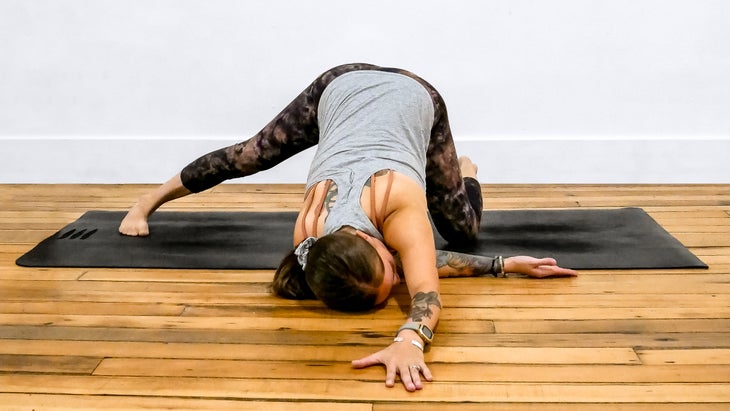
Why this prepares you for Compass Pose: This pose abducts your hips, lengthens your hamstrings, twists your thoracic spine, and internally rotates your shoulders.
How to: From hands and knees, sweep or slide your right foot straight out to your right side so your heel is in line with your left knee. Press down into the ground through the pinky toe edge of your right foot. Walk your hands forward about 1 foot in front of your shoulders and slide them almost as wide as the mat like you’re coming into Uttana Shishosana (Extended Puppy Pose). Either stay here or bring your right arm into a twist by threading it behind your left wrist and bringing your right cheek to the mat. Stay here for several breaths. Unwind. Repeat on the other side. Come back to hands and knees.
Half Splits With Twist
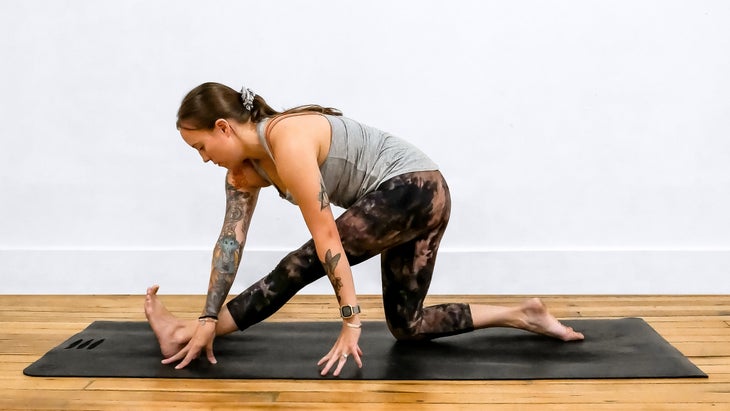
Why this prepares you for Compass Pose: This eccentrically lengthens your hamstrings. If you bring your hands to the outside of your shin, it will also laterally rotate your leg and abduct your hips while also providing a twist to prepare your side body.
How to: From hands and knees, step or wiggle your left foot in between your hands and then begin to inch your right knee behind you to your comfort level. If your hands don’t reach the ground, use a couple blocks as limb extenders. The essential thing here is to stack your hips over your right knee and not slip into the common tendency to sit too far back, which causes you to lose some of the stretch in your front hamstring.
From here, press the back of your left heel into the mat and, without moving your foot, try to push it away from you. Stay here or bring both of your hands to the outside of your left shin for a slight twist. If you take the twist, make sure both of your hips remain facing the front of your mat. You might need to draw your left hip slightly back. Repeat on the other side. Come back to hands and knees.
Downward-Facing Dog With Cat-Cow
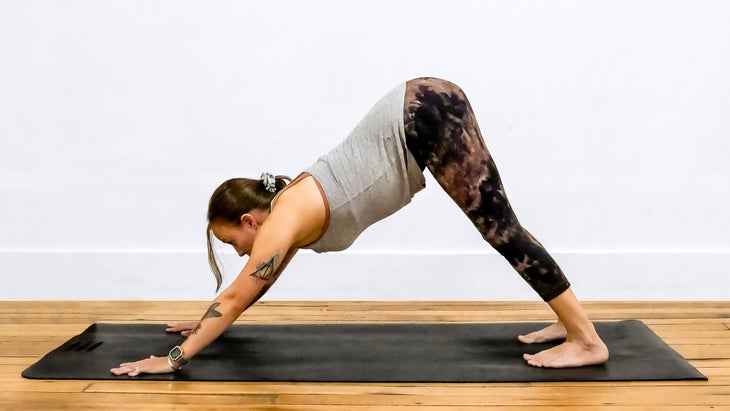
Why this prepares you for Compass Pose: This movement opens your shoulders by protracting and retracting them.
How to: From hands and knees, press into your hands and lift your hips up and toward the back of your mat into Adho Mukha Svanasana (Downward-Facing Dog Pose). Press down through your heels to create length in your hamstrings, even if your heels don’t touch the mat. Exhale and start to come into Marjaryasana (Cat Pose) while still in Downward-Facing Dog by rounding your back and tucking your chin.
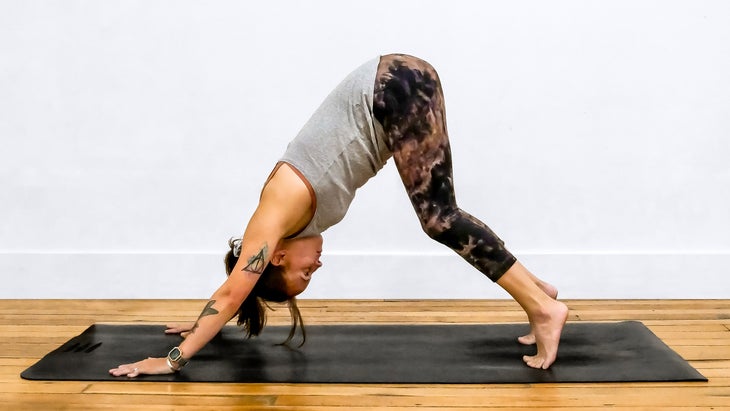
Inhale and come into Bitilasana (Cow Pose) in Downward-Facing Dog by arching your back. Repeat several times.
Chair Pose
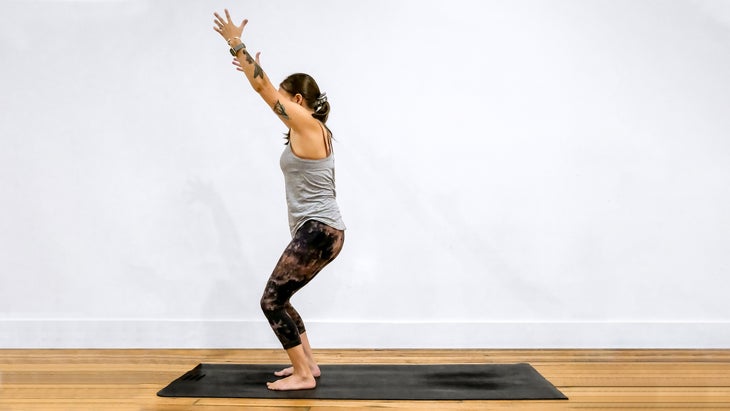
Why this prepares you for Compass Pose: This pose abducts your hips and engages your hamstrings.
How to: From Downward-Facing Dog, make your way to the front of the mat. For this variation of Utkatasana (Chair Pose), keep your feet about hip-distance apart. Reach your arms alongside your ears, bend your knees, and sink your booty back. Stay in the pose as you press down through your heels and lift through the top of your head.
Bring your arms straight out from your shoulders with your palms pressing away from you toward the side walls. Pinch your shoulder blades together. Begin to twist to the left, bringing your left palm to face the back of the mat and your right palm toward the front. Make sure that your pelvis remains facing the front of the mat, which means you may need to bring your left hip slightly forward.
Chair to Half Moon Pose Transition
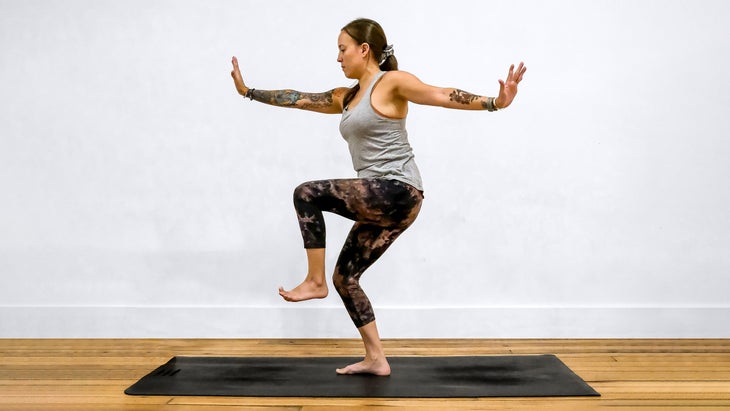
Why this prepares you for Compass Pose: This abducts your hips, engages your hamstrings, and twists your thoracic spine.
How to: From Chair Pose with twist, shift your weight to your right foot and lift your left knee toward your chest. You may wobble. That’s OK. Just pause and wait until you feel steady before you transition any more.

Slowly begin to press your left heel toward the wall behind you. At the same time, counterbalance yourself by leaning your right shoulder toward the mat in front of you.
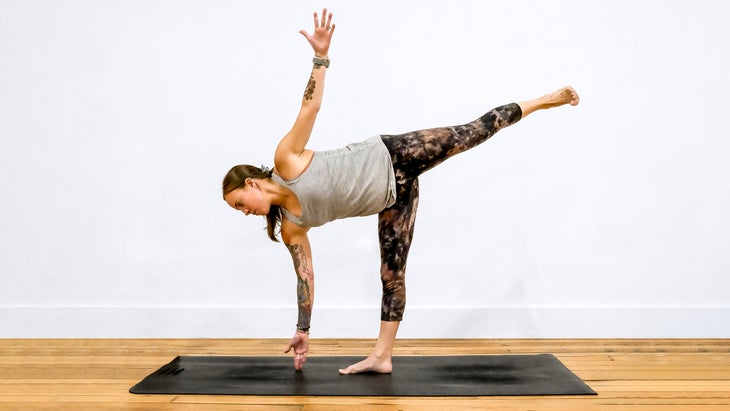
Eventually bring your right hand down to the mat or a block and boom—you’re in Ardha Chandrasana (Half Moon Pose)! You will be facing the left side of your mat. To really fire up your right hamstring, if you’re feeling super stable, feel as though you’re drawing your right sit bone toward your navel.
Chair Pose

Why this prepares you for Compass Pose: This engages your hamstrings.
How to: From Half Moon, transition to Chair in a three-step process. First, bring your left hand down to meet your right and turn both hips to face the mat to come into Standing Splits. Then draw your left knee toward your chest and gently step your left foot alongside your right. Once your feet are parallel to one another, bend your knees while pressing down into your heels, sink your hips back, and lift your arms toward the ceiling.
Boat Pose
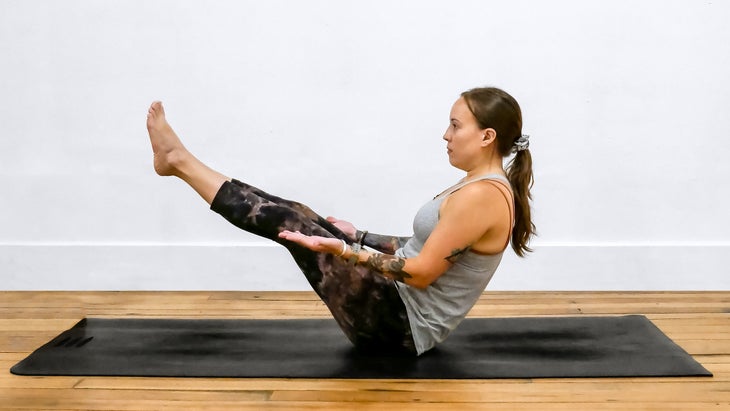
Why this prepares you for Compass Pose: This lengthens your hamstrings.
How to: From Chair, slowly lower your booty to the ground (you might need to “plop” or flop down depending on your ankle mobility). Then, lift your knees toward your chest and reach your arms toward the front of your mat in Paripurna Navasana (Boat Pose). Press your heels away from you and lift your chest toward the ceiling.
One-Leg-Raised Crunch

Why this prepares you for Compass Pose: This abducts your hips, engages your hamstrings, and protracts your shoulders.
How to: From Boat Pose, lower your upper body toward the mat until your shoulder blades are barely elevated and your legs are straight-ish and at a hover. This pose can be a doozy. Make sure that you’re still breathing here! If you’re unable to take a deep breath, this pose is not serving you. Instead, keep your heels on the mat and focus on slowing your breath.
Draw your right knee toward your right shoulder and on the exhale reach your arms forward as you draw your chest toward the wall in front of you, as if you were doing a crunch. Keep your left leg engaged and your left heel lifted off the mat, if your breath allows. (Really press your heel toward the front of your mat.) Lower and repeat. Do this 3–5 times. Come back to your crunch.
Squat

Why this prepares you for Compass Pose: This pose abducts your hips… a lot.
How to: From your crunch, bring both of your knees toward your chest then rock and roll from the back of the mat to the front until you have enough momentum to plant your feet at the front of the mat with your heels in, toes out in a yoga squat. Bring your hands into prayer and lift your chest.
Straighten your legs and fall forward into Uttanasana (Standing Forward Bend) or take a vinyasa by stepping or jumping back to Plank, Chaturanga Dandasana (Four-Limbed Staff Pose), Urdhva Mukha Svanasana (Upward-Facing Dog Pose), and Downward-Facing Dog. Repeat the sequence starting from Chair on the left side. Come into Downward-Facing Dog.
Warrior II Pose
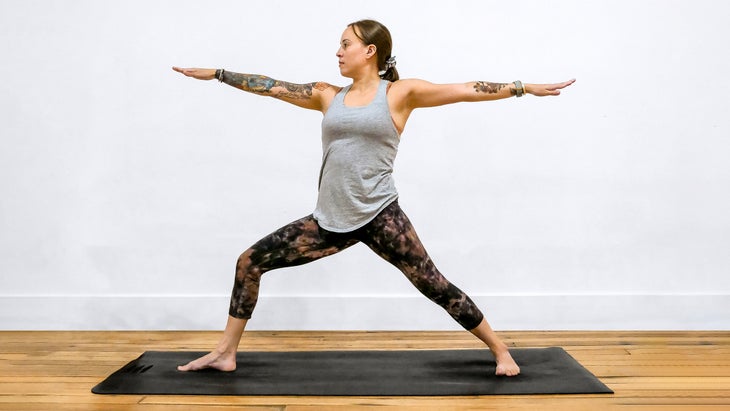
Why this prepares you for Compass Pose: This pose engages your hamstrings.
How to: From Downward-Facing Dog, step your right foot in between your hands and rise up to High Lunge with your arms raised above your head. Feel as though you’re pushing your left heel toward the wall behind you.
Turn out the back foot and rotate your pelvis toward the long edge of the mat and bring your arms parallel to the mat in Virabhadrasana II (Warrior II). Press your right heel into the mat and, without moving it, energetically draw it back toward your left foot to light up your hammy.
Extended Side Angle With Twist
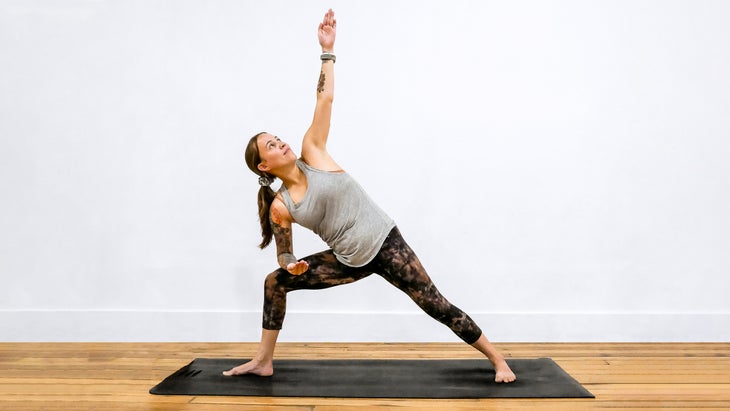
Why this prepares you for Compass Pose: This strengthens your hamstrings, provides thoracic rotation, and increases shoulder mobility.
How to: Keeping your legs in a Warrior II stance, lean forward to bring your right forearm toward your right thigh and lift your left arm toward the ceiling.
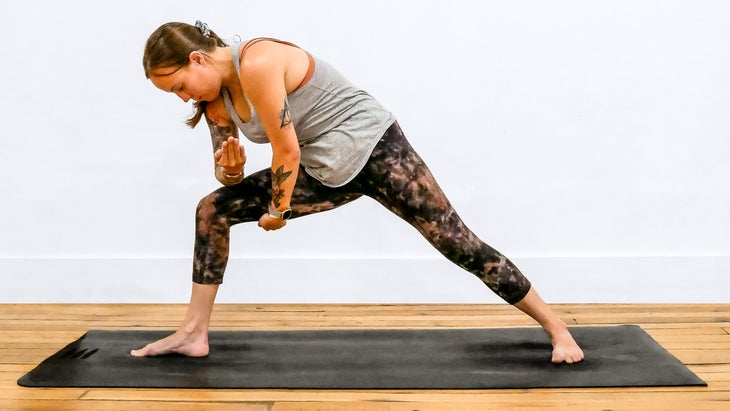
Exhale and roll your left shoulder down as you twist from your middle back to bring your left hand to touch your right hamstring. Inhale and unwind. Continue this twist, 1 breath per movement, for 5–7 breaths. Come back to the traditional Utthita Parsvakonasana (Extended Side Angle) in which your left arm is reaching overhead.
Extended Triangle Pose
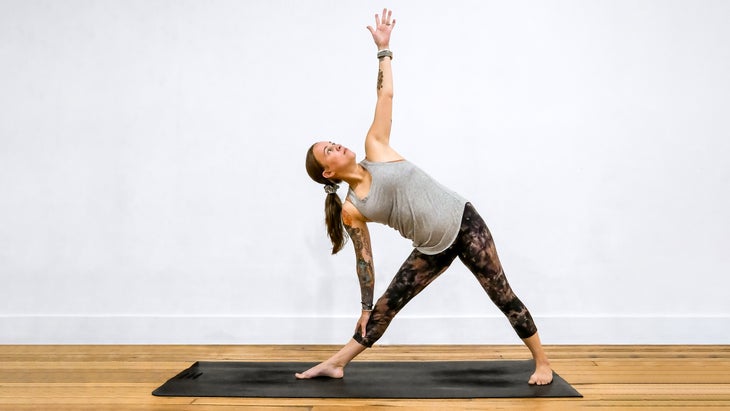
Why this prepares you for Compass Pose: This pose engages your hamstrings and protracts your shoulders to help with mobility.
How to: From Extended Side Angle, begin to straighten your right leg. At the same time let your left arm pull your chest up toward the ceiling and find your way into Utthita Trikonasana (Extended Triangle Pose). Keep your right hand on your right shin or a block and pull your right hip in toward the center of the mat. Then, slightly rotate your right ribs up toward the ceiling.
Remember: Triangle is a HUGE challenge, so if you’re finding that you’re unable to reach your shin or take a deep breath, grab a block and place it alongside your right ankle and rest your right hand on it.
Fallen Flamingo
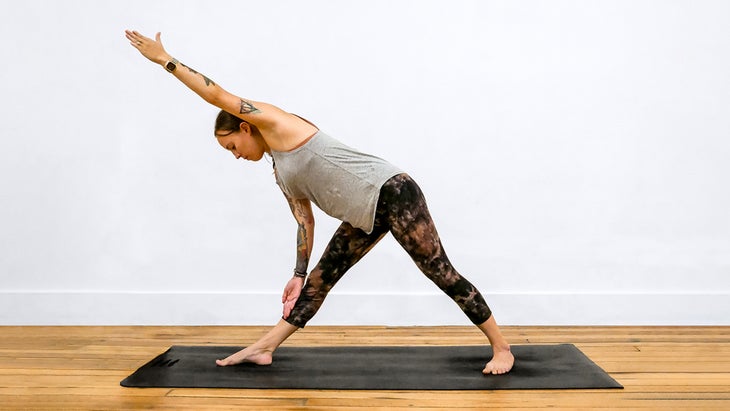
Why this prepares you for Compass Pose: This transition and pose provide an insane amount of hamstring strengthening. They also require hip abduction and shoulder protraction.
How to: From Extended Triangle, start to bring your left hand toward the top left corner of your mat. Start to bring your right hip toward the back of the mat.
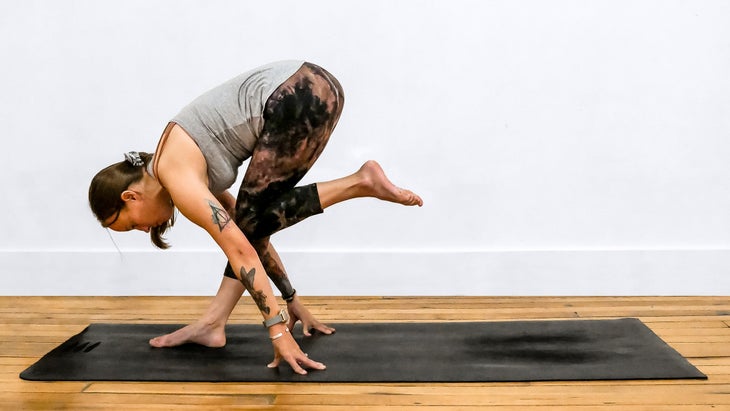
Bring your left hand to the mat, and at the same time, lift your left heel. Try to keep your right leg straight. You’ll be sorta in between High Lunge and Pyramid.
Walk your hands back about two feet with your fingers reaching toward your back foot. Step your left foot forward a little, then bring a slight bend to your right knee and press down through your right heel. Either stay here or press down into your fingertips to steady yourself, bend your left knee, and bring it toward your navel at the same time you press your left heel toward your glute. This is Fallen Flamingo.
Crooked Monkey
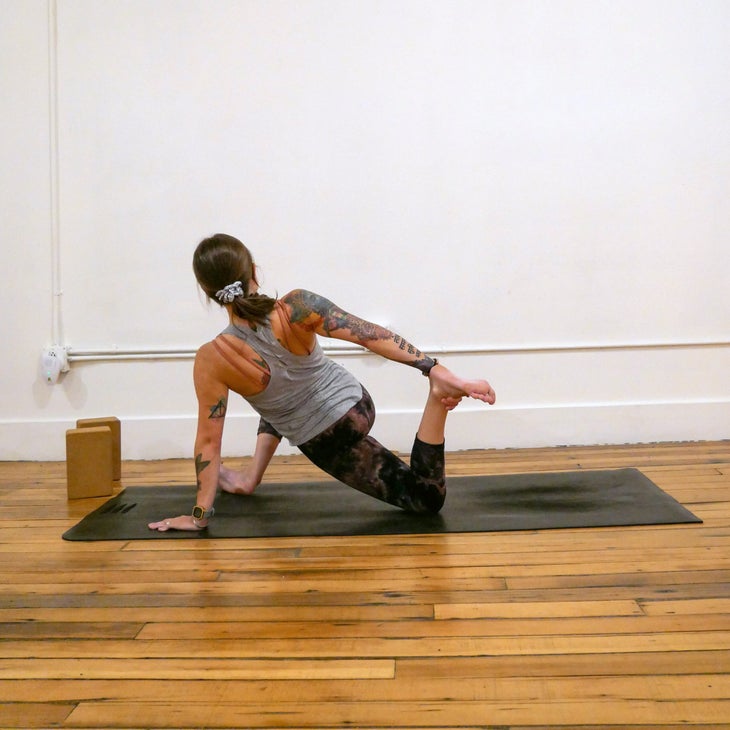
Why this prepares you for Compass Pose: This provides hip rotation, hip abduction, and external shoulder rotation.
How to: Let’s take it down a notch. From Flamingo, bring your hands to the mat beneath your shoulders and slide your left foot back in Anjaneyasana (Low Lunge). Set your back knee down. Bring your hands to the inside of your right foot and roll onto the outer edge of your right foot. Either stay here or bring your right hand to your right thigh and twist to the right in Crooked Monkey. If you like and you can do so without experiencing any knee pain, you can bend your left knee and reach for your ankle or foot with your right hand. Stay here for 3–5 breaths.
Low Lunge
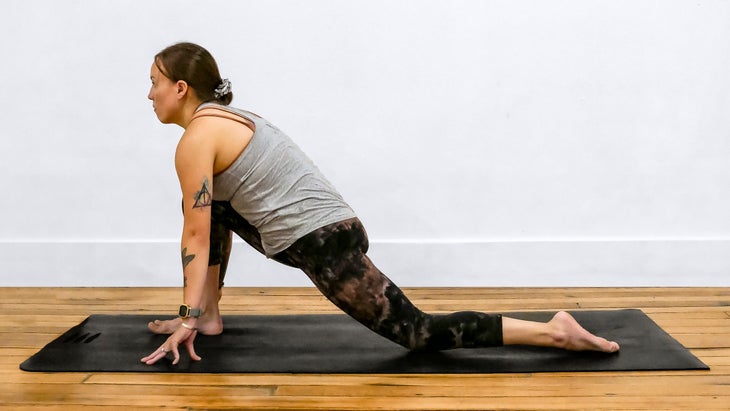
Why this prepares you for Compass Pose: This pose provides hamstring lengthening.
How to: From Crooked Monkey, bring your right hand outside your right foot. Press your right heel into the mat and, without moving it, try to draw it toward the back of your mat.
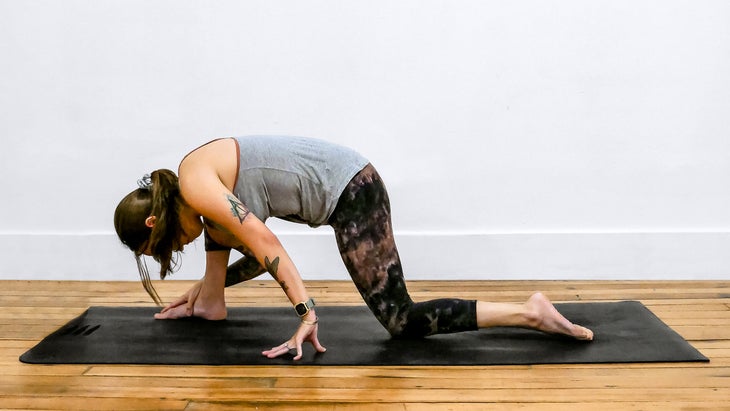
Stay here or slowly start to bring your right shoulder under your right thigh by first lowering the shoulder and tucking it beneath your thigh. Regardless of whether you actually bring your shoulder underneath your leg, start to feel as though you’re dragging your right heel toward the back of your mat and press your left heel toward the wall behind you. Stay here for 3–5 breaths.
Come to Downward-Facing Dog. Repeat the sequence starting from Warrior II on the left side. Come into Downward-Facing Dog.
Camel With Bind
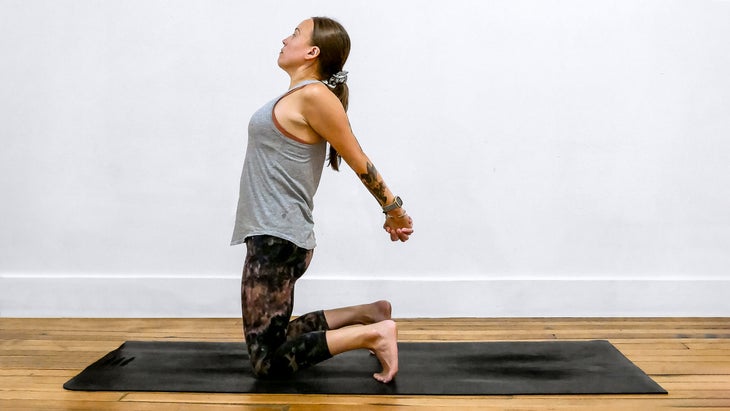
Why this prepares you for Compass Pose: Provides external shoulder and arm rotation and helps open the chest for deeper twists.
How to: From Downward-Facing Dog, bring your knees to the mat, hip-distance apart. Come into a kneeling position. Then interlace your fingers behind your back and lift your chest. If you want to get intense, keep a bend into your elbows to engage your chest. Stay here for 3–5 breaths. Release your bind.
Reverse Tabletop
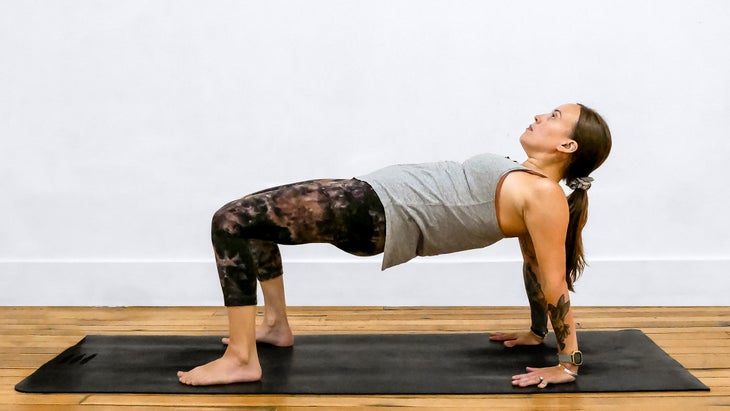
Why this prepares you for Compass Pose: This provides a lot of internal shoulder rotation.
How to: From Camel, come onto your glutes, bend your knees, and bring them about hip-distance apart. Place your hands about a foot behind your bum with your fingers pointed toward the front of your mat. Press down with your feet and lift your hips. Keep pressing down with your heels and pushing your hips toward the ceiling. It might feel nice to relax your head back. Stay here for 3–5 breaths. Then lower your bum to the mat.
Seated Straight Leg Stretch
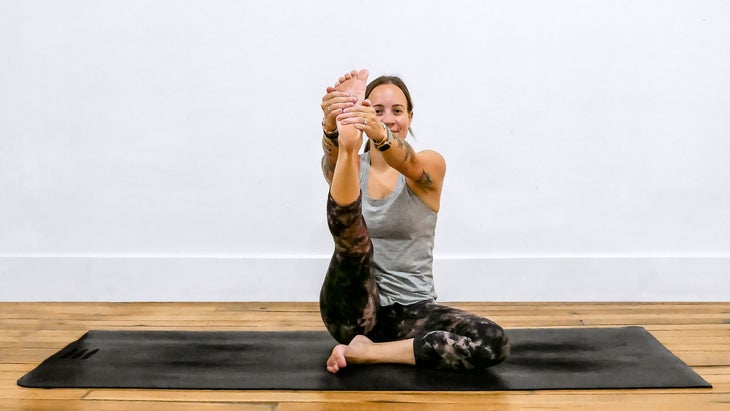
Why this prepares you for Compass Pose: Provides hamstring lengthening, thoracic rotation, and shoulder mobility.
How to: From seated on the mat, bend your left knee and bring the sole of that foot by your inner right thigh. Bring your right knee toward your chest, reach for your foot, and hold onto either side of it. Begin to straighten your right leg by pressing through your heel. It’s fine if you need to keep a bend in your knee but keep lifting through your chest so you’re not slouching forward.
If you want, bring your left hand on the outer edge of your right foot and bring your right arm toward the back of your mat, palm facing away from you, for a twist. Come back to facing forward.
Foot To Elbow Crook
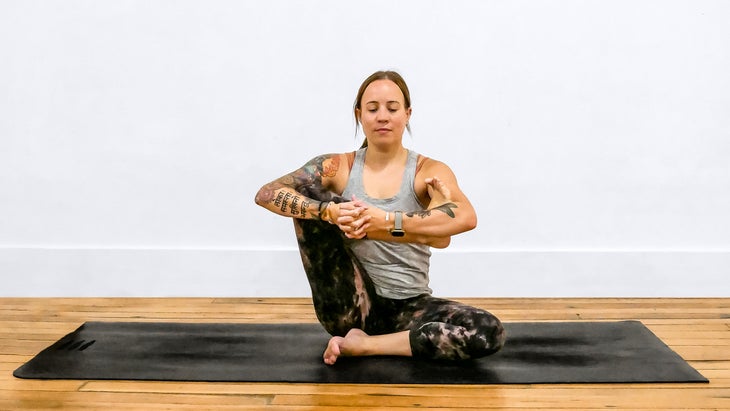
Why this prepares you for Compass Pose: Provides hip abduction.
How to: From seated, bend your right knee and bring your right foot toward your left elbow crook. Cradle your right shin with both arms and lift your chest. Pause here, close your eyes, and breathe while you remain in the stretch.
Compass Pose
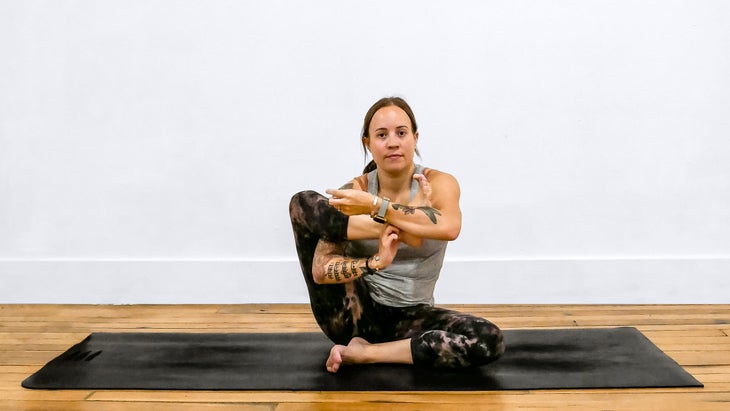
It’s time for Compass Pose. You got this! Release your right foot but keep hold of the pinky edge with your right hand and bring it toward your right shoulder. Bring your right leg back and your right shoulder forward. Then, lift your right shin and bring your right shoulder under. (It genuinely doesn’t matter where your shoulder to shin ratio is.)

Bring your right hand out to your side with your fingers pointing away from you. Now, keep in mind that the pose requires a lot of hamstring flexibility, and letting go of the idea that you need to completely straighten your leg. Begin to press your right foot away from your shoulder as you bring your left hand to the outer edge of your right foot.
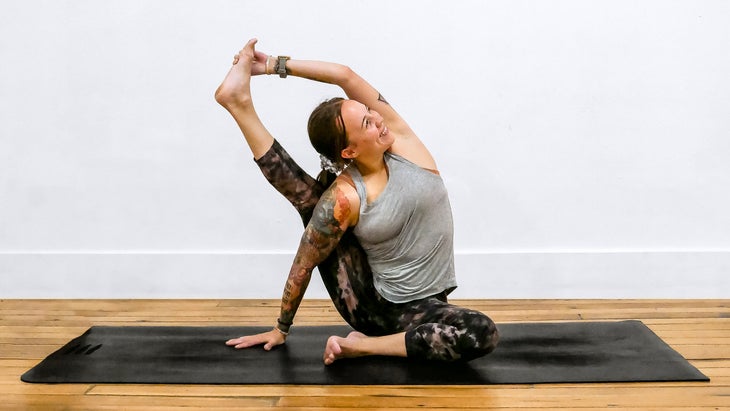
Start to straighten your right leg. Once you reach the full depth of your version of the pose—meaning whatever feels right and not too strenuous or strained for you—stay here for 3–4 breaths.
Slowly release. Repeat beginning with Seated Straight Leg Stretch on the left side. Indulge in your favorite forward bends, such as Paschimottanasana (Seated Forward Bend) and any reclined twists, and take Savasana (Corpse Pose).
See also Yes, You Can Come Into Visvamitrasana
About our contributor
Ashlee McDougall is a self-proclaimed yoga nerd. She’s completed more than 1,500 hours of yoga teacher training with expert teachers including Janet Stone and Jason Crandell. She enjoys creating sequences that help you build strength and mobility and is very passionate about offering trauma-aware and inclusive classes. You can follow her on Instagram at @Ashlee.McDougall and take her class at Bhava Wellness in Tucson, Arizona.